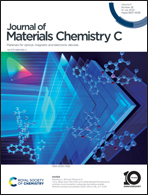A novel azo dye molecule enables defect passivation and crystallization toward efficient perovskite solar cells†
Abstract
Organic–inorganic perovskite solar cells (PSCs) have attracted widespread attention in improving photovoltaic efficiency during the past decade, yet the stability and defect passivation engineering of PSCs are still challenging. Herein, a novel dye N-(4-(phenyldiazenyl)phenyl) acetamide (Ph-azo-PhAmi) was synthesized and introduced as a passivator into a perovskite to reduce the defects and enhance the efficiency. The amide group in Ph-azo-PhAmi could interact with the defects of the perovskite, resulting in the decreased trap states and suppressed non-radiative recombination. Due to the azo bond, the Ph-azo-PhAmi possessed π-conjugated properties, and could form steady-state polymer-like structures by π–π stacking to enhance the passivation effect. As a result, the power conversion efficiency (PCE) of PSCs based on Ph-azo-PhAmi increased to 20.85% with matched energy levels and negligible hysteresis. The unencapsulated PSCs with Ph-azo-PhAmi retained 85.7% of the initial PCE after storage in ambient air (room temperature, 65–75% relative humidity) under dark conditions for 300 h, revealing a significantly enhanced ambient stability compared with the pristine PSCs (26.9%). This work provides a promising method for fabricating high-performance and well-stability PSCs based on a dye additive.



 Please wait while we load your content...
Please wait while we load your content...